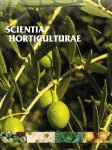Ver ítem
- xmlui.general.dspace_homeCentros Regionales y EEAsCentro Regional Mendoza - San JuanEEA JunínArtículos científicosxmlui.ArtifactBrowser.ItemViewer.trail
- Inicio
- Centros Regionales y EEAs
- Centro Regional Mendoza - San Juan
- EEA Junín
- Artículos científicos
- Ver ítem
Effect of olive hedgerow orientation on vegetative growth, fruit characteristics and productivity
Resumen
The effect of row orientation on oil production and fruit characteristics was studied, during years 3–6 after planting of the super-high density olive hedgerows (1923 tree/ha) planted at the same row spacing (4 m) in four orientations (N–S, NE–SW, NW–SE and E–W). During the last two years of observations the hedgerows were maintained by lateral pruning and topping at the same row width (1 m) and height (2.5 m). In those years, maximum fruit yield was
[ver mas...]
The effect of row orientation on oil production and fruit characteristics was studied, during years 3–6 after planting of the super-high density olive hedgerows (1923 tree/ha) planted at the same row spacing (4 m) in four orientations (N–S, NE–SW, NW–SE and E–W). During the last two years of observations the hedgerows were maintained by lateral pruning and topping at the same row width (1 m) and height (2.5 m). In those years, maximum fruit yield was achieved by NE–SW and NW–SE (15.7 t/ha). Of these, NE–SW achieved the highest oil yield (2.7 t/ha). There were no differences in fruit or oil yield between N–S (2.5 t oil/ha) and E–W (2.3 t oil/ha) orientations. Fruit density was the most important component to explain these differences, by previous influence on number of buds developed and fruit set. Analyses of profiles of yield components and yield on opposing sides of hedgerows revealed many differences that contributed to overall hedgerow performance. Regardless of row orientation, fruit density was highest from 1.0 to 2.0 m height, decreasing to the top and to the base. In both sides of N–S and also in N side of the E–W hedgerows, fruit weight decreased linearly from top to base, whereas on both sides of NE–SW and NW–SE and S side of E–W hedgerows, fruit weight decreased linearly from the top layer to 1.4 m height and remained stable to depth. Fruit ripening was also highest in the top layers and decreased linearly to the base in all orientations, but was more evenly distributed in the S and SW sides of E–W and NW–SE hedgerows. Fruit water content increased linearly from top to base in all orientations, more sharply in NE–SW, NW–SE and N–S hedgerows. The discussion explores the role of light relations in the determination of yield in olive hedgerows and options for future study and selection of optimal hedgerow designs.
[Cerrar]

Autor
Trentacoste, Eduardo Rafael;
Connor, David J.;
Gómez del Campo, María;
Fuente
Scientia Horticulturae 192 : 60-69 (August 2015)
Fecha
2015-08-31
ISSN
0304-4238
Formato
pdf
Tipo de documento
artículo
Palabras Claves
Derechos de acceso
Restringido
 Excepto donde se diga explicitamente, este item se publica bajo la siguiente descripción: Creative Commons Attribution-NonCommercial-ShareAlike 2.5 Unported (CC BY-NC-SA 2.5)
Excepto donde se diga explicitamente, este item se publica bajo la siguiente descripción: Creative Commons Attribution-NonCommercial-ShareAlike 2.5 Unported (CC BY-NC-SA 2.5)

